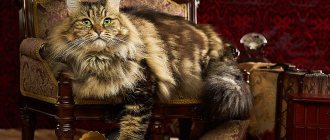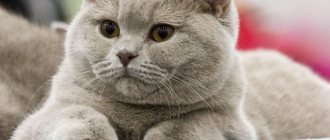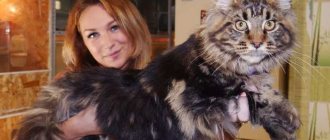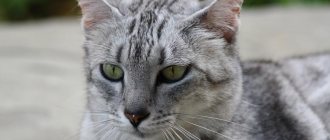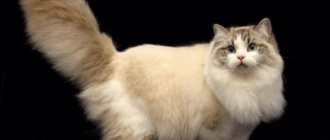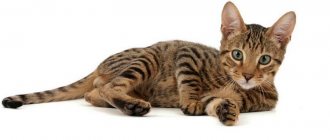Among hairless animals, the most famous are hairless Egyptian cats. Despite the fact that the breed was officially registered only in the middle of the 20th century in the USA, the first mentions of unusual cats are found in ancient chronicles.
This breed received its further development thanks to the work of breeders and breeders in America and Canada. They managed to fix a genetic recessive mutation and breed completely hairless animals, which are today recognized by the vast majority of international felinological organizations. The name of the hairless Egyptian cat is Sphynx. We will talk about the characteristics of this breed, the nature of the animals and the rules for caring for them in this article.
History of the Sphinxes
Egyptian hairless cats were sacred animals of Egypt that lived in temples. It was believed that they were intermediaries between man and the gods. Sculptural images of these cats guarded the entrance to the sanctuaries and tombs of the Egyptian pharaohs.
In surviving manuscripts, other nationalities also mentioned their existence - the Aztecs, Indians and Mexicans. Experts believe that the breed of Egyptian hairless cats is one of the most ancient on our planet.
Hairless Egyptian cats have lost their popularity over time. However, the breed was revived in Canada and the USA in the second half of the 20th century. The Egyptian hairless cat reappeared in Toronto in 1966. One ordinary short-haired purr gave birth to a completely hairless kitten.
The unusual breed received its modern development thanks to the efforts of breeders and breeders from America. They managed to fix the genetic mutation and breed completely hairless cats, which quickly attracted the interest of animal lovers all over the world. Tatyana Smirnova, who brought two representatives of the breed from America, was engaged in breeding hairless cats in our country.
History of appearance
The first mentions of hairless cat breeds can be found in ancient documents. Such an animal was on the same level of importance as “naked” domestic dogs. The Egyptians deified the cat: images of it decorated the walls of temples and ancient writings.
In 1903, the Sphynx brother and sister were described in The Book of Cats. They were called the last representatives of this breed. The owner did not cross the kittens of the same litter, and this was equivalent to the fact that the exotic gene would disappear forever. However, after some time in Canada, a completely ordinary cat gives birth to a hairless kitten.
The second branch of the breed occurs in Russia: in Rostov-on-Don, a local resident picks up a hairless cat on the street, which will later give birth to her copy. And in 1994, the Peterbald breed was established - the St. Petersburg type of hairless cats.
External features
Egyptian hairless cats, photos of which we posted in this material, have a very unusual appearance. At the same time, they have a certain magic and magnetism. These are medium-sized animals, weighing no more than seven kilograms. Despite their seemingly slight build, they are muscular and strong. On a large wedge-shaped head, large ears and expressive oval eyes are set wide apart.
Sphynxes have a somewhat convex belly, a broad chest, long limbs and a thin, long tail. Their skin is wrinkled, especially in the neck, head and shoulder girdle. This gives the animals a rather gloomy appearance. Fans of fluffy cats often find this breed unattractive, but thousands of people consider their appearance to be sophisticated and aristocratic.
Appearance
The outlines of their body and head are soft, smooth, and there are no straight lines in the figure. These cats have massive chests and a round belly, like a ball. The front legs are slightly crooked, but this does not prevent the animals from moving gracefully. The hind legs are slightly longer than the front ones, and the tail is flexible, like a whip. Sphynxes do not have mustaches, but their ears are quite large (for domestic cats). The eyes are shaped like lemons, and according to the standard they are in harmony with the color.
Such cats are often called “hot water bottles”: the temperature of a hairless kitten is approximately 42 degrees, adults are a little “colder”: 39-40 degrees. They have thick skin with numerous folds. Kittens of this breed are completely wrinkled for the first month, but as they grow older, all their folds disappear. The more folds on a cat's body, the higher its value is estimated. If there are no folds at all, such a cat is considered a “marriage” and is no longer called a sphinx.
The Sphynx feels like kid suede to the touch. The velvety effect is created due to the short fluff that is on the skin. Due to their pronounced pigmentation, sphinxes have a clear color: most often they are white, less often they have a solid or tortoiseshell skin color.
Where's the wool?
A special feature of the Sphinx is its fur, or rather its absence. Why are Egyptian cats hairless? According to felinologists, this is due to a natural mutation of the gene responsible for fur, which was later fixed by crossing with short-haired animals. In fact, the descendants of Egyptian hairless cats have hair on their skin, but it is so short and thin that it is impossible not only to see it, but also to feel it when stroking the Sphynx.
Sometimes there is pubescence on the face, ears, tail, paws and groin. These animals do not always have eyebrows and mustaches.
Health and life expectancy
The average life expectancy of sphinxes is 12-15 years.
Following the requirements of proper nutrition and a balanced diet, these cats rarely visit veterinary clinics. Health problems are often caused by hypothermia and poor hygiene. Problems may arise due to the animal's prolonged exposure to sunlight. However, there are diseases characteristic of sphinxes - urticaria, various skin irritations, rashes. For them, one of the health problems is hypertrophic cardiomyopathy.
With it, the septum between the ventricles of the heart suffers. However, geneticists have no evidence that it is associated with poor heredity. Another disease is myopathy - it is inherited. This disease is common in Devon Rex dogs. The Sphynx's body temperature normally reaches 39 degrees, which is much higher than that of other cat breeds.
Sphynx colors
In the description of Egyptian hairless cats, various colors are mentioned. The breed standard allows several of them.
Plain:
- grey:
- lilac;
- white;
- ginger;
- black;
- pinkish and blue.
Bicolor:
- grey-lilac;
- white-gray;
- black chocolate;
- tabby;
- biocolor (primary color + white);
- color point (reminiscent of the color of Siamese cats).
Under the sun's rays, such a pet can tan, and then its color becomes brighter.
Varieties of the Sphynx breed
Today there are seven varieties of the Sphynx breed. Three of them are called pioneers - the main branches of the breed that arose as a result of spontaneous mutation, naturally. The rest are a product of selection; they were bred later.
As a result of spontaneous mutations, the following appeared:
- Canadian Sphynx;
- Don Sphinx;
- Cohona (rubber, Hawaiian hairless)
As a result of breeding programs, the following were developed:
- The Peterbald was obtained by crossing the Don Sphynx and an Oriental cat.
- Minskin, the Canadian Sphynx, Munchkin, Devon Rex and Burmese were used for breeding.
- Bambinle is a Canadian Sphynx and a Munchkin.
- Ukrainian Levkoy was obtained by crossing the Don Sphynx, Peterbald, Oriental, Scottish Fold, Persian, and domestic cats.
Egyptian hairless cats: character
Despite the fact that representatives of the breed do not have the most attractive appearance, this disadvantage is more than compensated by their friendly character, devoid of even a hint of aggression. These animals are fun and playful, so if you are planning to buy an Egyptian hairless cat, be prepared to clean up after her.
Sphinxes really need human attention. They love it when their owners talk to them. Hairless cats have a hard time being alone. Representatives of the breed are characterized by depression due to lack of communication. It manifests itself as lethargy and apathy of the animal.
It’s not for nothing that felinologists call sphinxes the aristocrats of the cat world: they are extremely vulnerable. Therefore, ideally, the owner should choose company for such a pet, especially if a long trip is planned. Sphinxes get along well with all animals, and they are not afraid of dogs at all and communicate with him as equals.
Hairless cats have a rather contradictory character. They, like dogs, can spend several hours anxiously waiting at the door for their beloved owner. Seeing their owner after a long separation, they do not hide the joyful emotions that engulf them. Hairless cats are active and have a lively character. They will not refuse toys, special exercise equipment, and during the owner’s absence they often entertain themselves, which can become a problem for owners who do not know how to curb their pet’s irrepressible temperament and wean it from playing with curtains and climbing through cabinets.
Hairless cats easily find a common language with children, although they do not feel any special affection for them: they behave with restraint and even coldness. In this regard, breeders do not recommend purchasing such a pet for families with very young children. It is better for them to pay attention to more patient and affectionate pets, such as Ragdolls or Scots.
They usually avoid strangers in the house or demonstrate complete disinterest in communication in front of guests. But they will never allow themselves even a hint of aggression towards a stranger. If they are particularly fond of a stranger, they may demonstrate their unusual eating skills using their front paws. And the talents of these smart animals don’t stop there.
These unusual cats reveal the softer traits of their character to their owners - they become attached to all family members, although they single out one owner, who gets the lion's share of love and affection. Representatives of this breed do not have a hunting instinct, which is due to their decorative nature. Hairless cats do not have whiskers, so they cannot survive outside.
Sphynx temperament
Sphinxes are naturally gifted with intelligence and good memory. Among the representatives of this breed there are the most intelligent cats that are easy to train and teach various tricks. These animals are extremely intelligent, but require some education to develop their natural qualities. The hairless Sphynx cat, whose breed description indicates natural curiosity, requires constant supervision. A cat should not be left unattended for long periods of time as it may end up in a potentially dangerous situation.
Domestic Sphynx cats are quite often active and active. They do not refuse entertainment, toys, anchor simulators, so they can play independently in the absence of a master. The Sphinx's spontaneous antics often become a source of headaches for owners who do not know how to tame their pets' temperament and teach them to climb through cabinets and play with curtains.
By nature, Sphynxes are the most unusual cats with contradictory temperaments. Like dogs, they can stand at the door for hours waiting for their owner to return home. Cats do not hide their joy and tenderness when they see their owners after a long separation. At the same time, the Sphynx cat does not show much affection for other pets and children; it behaves coldly and reservedly towards them.
For this reason, breeders do not often offer families with growing children the purchase of a Sphynx cat, the price of which is about $1,000 for a show-class animal. Families with children should look for gentler, more patient pets such as Scotties or Raigdolls.
Intelligence
By nature, hairless cats are generously endowed with a sharp mind and good memory. They are easy to train and can perform various tricks. For example, opening doors, bringing small objects in the teeth to the owner, etc. They get used to the tray instantly, you just have to show where it is. Sphinxes are smart, but they need training to bring out their best natural qualities.
Hairless cats are extremely curious, so constant monitoring of such a pet is necessary. The Sphinx should be raised without screaming or physical influence. The animal simply will not understand the reason for such treatment. Use a stern, emotional tone in your speech if your pet has done something wrong.
Sphinx character
Sphinxes have a versatile and rich character. These are smart, intelligent animals that show a complete understanding of the words and requests of the owner, and easily remember simple commands and their name. Hairless cats prefer to lead an active lifestyle; they like to follow their owner, overcome obstacles, and jump from one object to another. There is something doggy about them, they also love to play, fetch objects, they become very attached to their owner, miss him, and seek companionship.
The breed is considered decorative, so cats have almost no hunting instinct. They get along well with other animals and are not afraid of large dogs. They are kind and affectionate, but sometimes they can turn into a real fury, showing their teeth and claws to the enemy. Each individual has character traits; behavior is not always a character trait of the breed.
The owners of sphinxes say that the animals seem to understand that they are completely dependent on humans and are grateful to him for his care. This breed of cat lacks not only fur, but also whiskers, the most important cat “device”. If you find yourself on the street or in the wild, the sphinx will die almost immediately.
Hairless cat health
When purchasing a defenseless, wrinkled, naked kitten, owners should know that at home, with good care, Sphynx cats live on average about 14 years, and they need special care. Due to the lack of fur, these animals are sensitive to climate and weather changes. They cannot easily tolerate extreme cold or heat.
Sphynx cats suffer from hyperhidrosis. Impurities and oil deposits accumulate on their skin. Therefore, it should be wiped regularly with a damp sponge.
Hairless cats are prone to developing allergic reactions that manifest as skin rashes.
Why is the cat a sacred animal in Egypt?
For several centuries, archaeologists have found cave paintings, vases, and figurines depicting cats in Egypt. And this may already be a sign that even in ancient times the Egyptians revered and respected these animals. Cats in Ancient Egypt were decorated, given various gifts and worshiped. According to scientists and according to documents that have survived to this day, cats occupied a special place in the history of the peoples inhabiting the Nile Valley. It was in Egypt that the cat was first tamed and domesticated. The pharaohs treated cats that lived in palaces with even more reverence. On the day the cat died, the pharaohs went into seventy days of mourning. Why did the Egyptians fall in love with cats? There are several versions.
Excellent rodent fighter
The most basic and widespread food product in Ancient Egypt were various cereals (barley, wheat). Rodents were a real disaster for people. Even a small population of mice could destroy all a family's grain reserves, thereby dooming the family to starvation. The Egyptians needed to preserve their crops, and cats could be the best protectors. Cats could also be good hunters, catching not only rodents, but also birds, which also caused great damage to crops.
Features of the religion of Ancient Egypt
Initially, before the formation of religion with the Pantheon of Gods, there was a Cult of Animals in Egypt.
People worshiped various animals and revered them for their power and strength. The Egyptians simply adored cats. They worshiped this animal so much that they practically made them gods. The cat's glowing eyes in the dark made the ancient Egyptians feel trembling fear. The ability of a cat to appear silently and disappear just as silently evoked respect mixed with horror, attributing it to magical properties available only to the Gods. The Egyptians admired these soft and furry creatures. There is evidence in historical literature that when a Roman cart driver accidentally ran over a sacred animal, he was immediately killed by an angry crowd that attacked him. If a cat was killed by someone in Egypt, it was considered a terrible crime and was punishable by death. Also, on pain of death, the export of cats from the country was prohibited. goddess Bastet
It was in Egypt that cats were given various gifts. There are many examples of this: the god Ra was depicted as a red cat. The ruler of the hearth, female beauty and fertility, the goddess Bastet (Bast) was depicted as a woman with the face of a cat. In honor of this cat goddess, temples were built and annual holidays were held, and the priests made sacrifices both to the goddess Bastet and to the cats who lived at the temples. The cat was loved for its cleanliness and immense care for its offspring. And these properties were also attributed to the goddess Bastet.
If there was a fire in the house, people would rush into the fire to make sure that there were no cats left there. Dead cats were mummified and buried with special honors, and the family shaved off their eyebrows as a sign of grief. The cult of Bastet was officially banned by Pharaonic decree in 390 AD. Thus, religious interest in cats began to wane in Egypt, and although they remained as pets, they were no longer objects of worship in temples.
Love played a cruel joke
But such a great love for cats once turned out to be a different side for the Egyptians. In 525 BC. Egypt was attacked by the Persians. The Persian king, Cambyses II, decided on an insidious, vile cunning. Using knowledge of the great love and religiosity of the Egyptians for cats, he ordered his warriors to attach cats to their shields. Thus, the Egyptians faced a difficult choice - break the law and kill the sacred animal or surrender with virtually no fight. In the end, we chose the second one. Thus, Cambyses II, thanks to his sophisticated cruelty and knowledge of the laws of another country, was able to conquer Egypt.
Only wealthy people could keep a cat in their home, since the cat required special care, which was not very cheap. Cats didn't just eat mice. The cats were given the best pieces of meat or fish.
Cats in Egypt today
Cats and people have lived together for more than 6,000 years. Despite this, unlike other domestic animals (cows, horses, dogs), the cat managed to maintain its primitive independence and free character. Today, in Egypt, the cat is as common a pet as in many other countries. Some people are avid cat lovers, while others can’t stand these fluffy creatures. But, nevertheless, living under one roof for such a long time could not help but leave its mark on the behavior of both people and cats. As before, they try not to offend cats (so as not to incur the wrath of the Gods). Man constantly uses cat motifs in his creativity, be it fine art, sculpture or cinema. Love and respect for cats seems to be already in the Egyptians' genes.
The Sphynx is Egypt's most famous cat
The Sphinx is a mythical creature with the body of a lion (a member of the cat family) and the head of a man, falcon or ram. The word itself is of Greek origin and is translated as “strangler.” The ancient Egyptian name of this creature could not be established. Such statues personified the pharaoh defeating his enemies. The statue of sphinxes was installed in temples and near burial vaults. The most famous Great Sphinx - one of the oldest sculptures on Earth - is located in Giza, on the west bank of the Nile, near the Pyramid of Cheops.
Currently, there is also a breed of Sphynx cats, which in turn is divided into:
— Don Sphynx;
— Canadian Sphynx;
— Petersburg Sphynx or Peterbald.
Nutrition
It is very important to discuss your unusual pet's diet with your veterinarian. It can be based on Royal Canin for cats, formulated taking into account the characteristics of this breed. You can choose another complete composition of good quality.
If the owner prefers to feed his pet natural food, then it should contain a lot of protein (offal, meat) with the addition of cereals and dairy products. In addition, caring for a Sphynx involves the following procedures:
- nail trimming;
- rubbing the eyes;
- ear cleaning;
- bathing.
How to care for a Sphynx
You can train your Sphynx to use the litter tray simply by showing him the right place to go. Even if the kitten does not understand this the first time, the kitten needs to be shown again. If the owner notices that the cat begins to behave unusually and begins to look for a place, it is necessary to immediately transfer the kitten to the litter box. In general, caring for an animal does not have any special conditions. The main difference in caring for this breed is its coat. A cat sweats a lot due to its high body temperature - the cat needs to be bathed frequently, at least once a week.
These cats need to be wiped down daily. This is best done with wet wipes. Dead fur hairs are removed in the same way. Ears and eyes should be cleaned periodically. To do this, you can use cotton swabs soaked in warm water. Once a week, it is important to wipe your eyes with a damp cotton pad to remove discharge from the tear ducts. You can use chamomile infusion or weakly brewed tea.
There are some requirements for swimming:
water temperature should be 36-38 degrees;- During the procedure, you need to talk to the animal in a calm, pleasant voice so as not to cause stress and discomfort;
- It is better to bathe the animal in thick, dense foam;
- You can’t wash your hair so that water doesn’t get into your ears;
- After bathing, the cat should be wrapped in a towel and dried well.
Once a month it is necessary to brush your teeth. To do this, you need to purchase special brushes. It is also necessary to cut your nails regularly. This breed is distinguished by long claws that require special attention.
How much does an Egyptian hairless cat cost?
The answer to this question is of interest to all people who are planning to purchase such an unusual pet. The cost of a Sphynx largely depends on the class of the chosen kitten. For example, a baby who in the future will be able to take part in exhibitions, including international ones, can cost more than a thousand dollars (64,800 rubles at today's exchange rate). Such a pet meets all existing standards and is allowed for mating.
If you do not plan to participate in exhibitions, you can purchase a pet-class kitten. It will cost you 200 dollars (12,970 rubles). Such animals have minor defects in the exterior, which do not allow them to be exhibited. This will not make your unusual pet any less loved. In any case, the price of the Sphynx is set by the breeder, and it is discussed individually at the time of the purchase and sale transaction.
Of all the variety of cats, hairless cats undoubtedly stand out in appearance. If you want to have a smart, intelligent pet who will be attached to you with all his soul, pay attention to this unusual breed.
Cost of a Sphynx kitten
Animal lovers who are attracted to hairless cats are interested in the average cost of a purebred Sphynx breed. The answer to the question of how much a Sphynx cat costs depends on whether the kitten belongs to a certain class. In particular, a Sphynx cat show, which can only be purchased from professional breeders, can cost over a thousand dollars. This pet meets all standards and can be used for mating.
In relation to strangers, Sphinxes are reserved and cold-blooded - they can show a complete lack of interest, but they will never allow themselves to show aggression towards a stranger. These unusual cats show softer character traits towards their owners - they are very attached to family members, showing friendship, tenderness and affection towards them.
Feeding the cat
Hairless cats have faster metabolic processes than other breeds. They need more calories to maintain their body temperature.
Complete diet
When feeding dry formulas, preference is given to super-premium or holistic food from the following brands:
- Hills;
- Royal Canin;
- Acana;
- Pro Plan.
Some cat owners choose natural food for their pets. In this case, the Sphinx’s diet includes:
- lean meats - rabbit, veal, turkey, chicken;
- sea fish;
- cereals cooked in water without salt - buckwheat, rice, oatmeal;
- fermented milk products – low-fat cottage cheese, yogurt, sour cream;
- vegetables that have undergone heat treatment - carrots, broccoli, spinach;
- quail or chicken eggs (no more than 2 times a week).
Sphynx cats should not be fed processed foods, sausages, snacks, smoked meats, sweets, pork, bones and potatoes.
Feeding frequency
Adult cats are fed 2 times a day - morning and evening. During the daytime, you can treat the sphinx with a small piece of treat. Small kittens should eat more often:
- from 1 to 3 months – 6 times a day;
- from 3 to 6 months – 4 times a day;
- from 6 to 9 months – 3 times.
Vitamins and minerals
There is no need to additionally introduce mineral and vitamin supplements into the Sphynx's diet if he eats high-quality industrial food.
Feeding is needed for cats that eat natural food. Complex preparations with vitamins must be given in courses 2 times a year. In order not to harm the health of the sphinx, you first need to show it to the veterinarian.
Proper nutrition for sphinxes
As with any other breed, both natural food and ready-made food are suitable for sphinxes. When choosing natural food, it is important to remember the ban on food “from the table”. The cat's diet may include raw or slightly cooked chicken, rabbit or beef. Once a week you need to give a boiled egg and sea fish (boiled and boneless). It is also necessary to include buckwheat porridge and oatmeal, boiled or raw vegetables in your diet. If your pet refuses vegetables, they can be chopped and mixed with ground meat. Sphynxes are also given cottage cheese and kefir, not every day, and low-fat varieties.
If it is not possible to prepare special food for the animal, it is worth switching it to ready-made food. The advantage of such feeds is that they are well balanced and save the owners time. But such food, both dry and wet, must be of good quality. Otherwise, problems with the skin and intestines cannot be avoided.
No matter how strange and unusual the Sphynx may look, this breed is very popular, especially among allergy sufferers. They make you fall in love, surprise, even evoke a feeling of disgust, but they do not leave anyone indifferent. And the owners of the sphinxes cannot understand how one can not love such a miracle of nature.
It is worth keeping in mind that this description is typical for the breed as a whole and may not completely coincide with the characteristics of a particular cat of this breed!
Naked Pets » Keeping Sphynxes » How to care for a Sphynx? »


